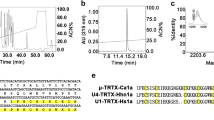Abstract
In this work, a novel M-superfamily conotoxin, designated lt3a, was purified from the crude venom of Conus litteratus. Combined with peptide sequencing, MALDI-TOF mass spectrometry and cDNA cloning techniques, the amino acid sequence of lt3a was supposed to be DγCCγ OQWCDGACDCCS, where O is hydroxyproline and γ is carboxyglutamate. The Cys framework of lt3a (–CC–C–C–CC–) is similar to that of ψ-, μ-, κM-conotoxins, which are representatives of M-conotoxins. Peptide lt3a is categorized into M1 branch based on the number of residues in the last Cys loop. Whole cell patch-clamp study on adult rat dorsal root ganglion neurons indicated that lt3a could enhance tetrodotoxin-sensitive sodium currents. This is a previously unknown function of M-superfamily conotoxins.




Similar content being viewed by others
References
Buczek O, Bulaj G, Olivera BM (2005) Conotoxins and the posttranslational modification of secreted gene products. Cell Mol Life Sci 62:3067–3079
Bulaj G, Buczek O, Goodsell I, Jimenez EC, Kranski J, Nielsen JS, Garrett JE, Olivera BM (2003) Efficient oxidative folding of conotoxins and the radiation of venomous cone snails. Proc Natl Acad Sci USA 100(Suppl 2):14562–14568
Cestèle S, Catterall WA (2000) Molecular mechanisms of neurotoxin action on voltage-gated sodium channels. Biochimie 82:883–892
Corpuz GP, Jacobsen RB, Jimenez EC, Watkins M, Walker C, Colledge C, Garrett JE, McDougal O, Li W, Gray WR, Hillyard DR, Rivier J, McIntosh JM, Cruz LJ, Olivera BM (2005) Definition of the M-conotoxin superfamily: characterization of novel peptides from molluscivorous Conus venoms. Biochemistry 44:8176–8186
Ekberg J, Adams DJ (2006) Neuronal voltage-gated sodium channel subtypes: key roles in inflammatory and neuropathic pain. Int J Biochem Cell Biol 38(12):2005–2010
Ekberg J, Craik DJ, Adams DJ (2008) Conotoxin modulation of voltage-gated sodium channels. Int J Biochem Cell Biol 40(11):2363–2368
Gross GJ, Warltier DC, Hardman HF, Shibata S (1985) Cardiotonic effects of anthopleurin-A (AP-A), a polypeptide from a sea anemone, in dogs with a coronary artery stenosis. Eur J Pharmacol 110(2):271–276
Hagen NA, Fisher KM, Lapointe B, du Souich P, Chary S, Moulin D, Sellers E, Ngoc AH, Canadian Tetrodotoxin Study Group (2007) An open-label, multi-dose efficacy and safety study of intramuscular tetrodotoxin in patients with severe cancer-related pain. J Pain Symptom Manage 34(2):171–182
Han YH, Wang Q, Jiang H, Liu L, Xiao C, Yuan DD, Shao XX, Dai QY, Cheng JS, Chi CW (2006) Characterization of novel M-superfamily conotoxins with new disulfide linkage. FEBS J 273:4972–4982
Jakubowski JA, Keays DA, Kelley WP, Sandall dW, Bingham JP, Livett BG, Gayler KR, Sweedler JV (2004) Determining sequences and post-translational modifications of novel conotoxins in Conus victoriae using cDNA sequencing and mass spectrometry. J Mass Spectrom 39:548–557
Jakubowski JA, Kelley WP, Sweedler JV (2006) Screening for post-translational modifications in conotoxins using liquid chromatography/mass spectrometry: an important component of conotoxin discovery. Toxicon 47:688–699
Jiang H, Wang CZ, Xu CQ, Fan CX, Dai XD, Chen JS, Chi CW (2006) A novel M-superfamily conotoxin with a unique motif from Conus vexillum. Peptides 27:682–689
Lewis RJ, Garcia ML (2003) Therapeutic potential of venom peptides. Nat Rev Drug Discov 2(10):790–802
Liu J, Wu Q, Pi C, Zhao Y, Zhou M, Wang L, Chen S, Xu A (2007) Isolation and characterization of a T-superfamily conotoxin from Conus litteratus with targeting tetrodotoxin-sensitive sodium channels. Peptides 28:2313–2319
Nicholson Gm, Walsh R, Little MJ, Tyler MI (1998) Characterization of the effects of robustoxin, the lethal neurotoxin from the Sydney funnel-web spider Atrax robustus, on sodium channel activation and inactivation. Pflugers Arch 436:117–126
Olivera BMEE (1997) Just Lecture, 1996. Conus venom peptides, receptor and ion channel targets, and drug design: 50 million years of neuropharmacology. Mol Biol Cell 8:2101–2109
Olivera BM (2006) Conus peptides: biodiversity-based discovery and exogenomics. JBC 81:31173–31177
Olivera BM, Cruz LJ (2004) Conotoxins, in retrospect. Toxicon 39:7–14
Pi C, Liu J, Peng C, Liu Y, Jiang X, Zhao Y, Tang S, Wang L, Dong M, Chen S, Xu A (2006) Diversity and evolution of conotoxins based on gene expression profiling of Conus litteratus. Genomics 88:809–819
Shi J, Liu TT, Wang X, Epstein DH, Zhao LY, Zhang XL, Lu L (2009) Tetrodotoxin reduces cue-induced drug craving and anxiety in abstinent heroin addicts. Pharmacol Biochem Behav 92(4):603–607
Terlau H, Olivera BM (2004) Conus venoms: a rich source of novel ion channel-targeted peptides. Physiol Rev 84:41–68
Wang MJ, Xiong SH, Li ZW (2001) Neurokinin B potentiates ATP-activated currents in rat DRG neurons. Brain Res 923:157–162
Acknowledgments
This work was supported by the State National High-Tech Development Program (863 Program) from the Ministry of Science and Technology of China (No. 2006AA090504 and No. 2008AA09Z401), National Natural Science Foundation of China (30871921), project of Guangdong Science-Tech Program (No. 2006A36501001), Guangdong Natural Science Foundation (8151027501000083). We thank Jingxing Ou of University of Aberdeen for his comments on this article.
Author information
Authors and Affiliations
Corresponding author
Additional information
L. Wang and J. Liu contributed equally to this work.
Rights and permissions
About this article
Cite this article
Wang, L., Liu, J., Pi, C. et al. Identification of a novel M-superfamily conotoxin with the ability to enhance tetrodotoxin sensitive sodium currents. Arch Toxicol 83, 925–932 (2009). https://doi.org/10.1007/s00204-009-0453-8
Received:
Accepted:
Published:
Issue Date:
DOI: https://doi.org/10.1007/s00204-009-0453-8




